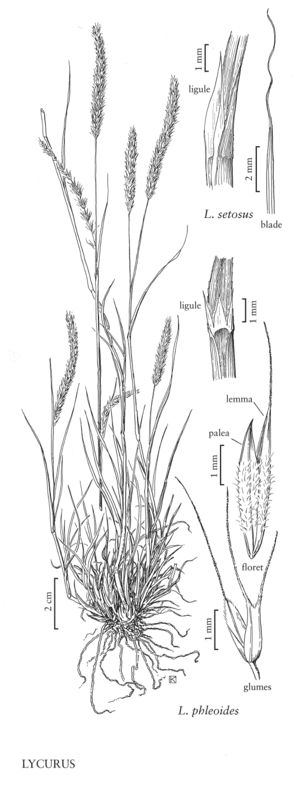Difference between revisions of "Lycurus phleoides"
Common names: Common wolfstail
Treatment appears in FNA Volume 25. Treatment on page 203.
FNA>Volume Importer |
imported>Volume Importer |
||
| (5 intermediate revisions by 2 users not shown) | |||
| Line 26: | Line 26: | ||
-->{{#Taxon: | -->{{#Taxon: | ||
name=Lycurus phleoides | name=Lycurus phleoides | ||
| − | |||
|authority=Kunth | |authority=Kunth | ||
|rank=species | |rank=species | ||
| Line 33: | Line 32: | ||
|basionyms= | |basionyms= | ||
|family=Poaceae | |family=Poaceae | ||
| + | |illustrator=Linda A. Vorobik;Karen Klitz | ||
| + | |illustration copyright=Utah State University | ||
|distribution=Maine;Okla.;N.Mex.;Tex.;Ariz.;Colo. | |distribution=Maine;Okla.;N.Mex.;Tex.;Ariz.;Colo. | ||
|reference=None | |reference=None | ||
| Line 38: | Line 39: | ||
|publication year= | |publication year= | ||
|special status= | |special status= | ||
| − | |source xml=https:// | + | |source xml=https://bitbucket.org/aafc-mbb/fna-data-curation/src/200273ad09963decb8fc72550212de541d86569d/coarse_grained_fna_xml/V25/V25_789.xml |
|subfamily=Poaceae subfam. Chloridoideae | |subfamily=Poaceae subfam. Chloridoideae | ||
|tribe=Poaceae tribe Cynodonteae | |tribe=Poaceae tribe Cynodonteae | ||
Latest revision as of 17:58, 11 May 2021
Culms 20-50 cm, erect to ascending, often geniculate. Ligules 1.5-3 mm, commonly acute to acuminate, with narrow trianfular lobes 1.5-3(4) mm long extending from the sides of the sheaths; blades 4-8 cm long, 1-1.5 mm wide, acute or mucronate, midribs sometimes extending up to 3 mm as a short bristle. Similar to Lycurus setosus in inflorescence and aspikelet characters, except the upper glumes occasionally with a second shorter, more delicate awn. 2n = 40, ca. 40.
Distribution
Maine, Okla., N.Mex., Tex., Ariz., Colo.
Discussion
Lycurus phleoides grows on rocky hills and open slopes, at elevations of 670-2600 m. It grows from the southwestern United States to southern Mexico, and in northern South America. It flowers from July-October.
Selected References
None.
Lower Taxa
None.
